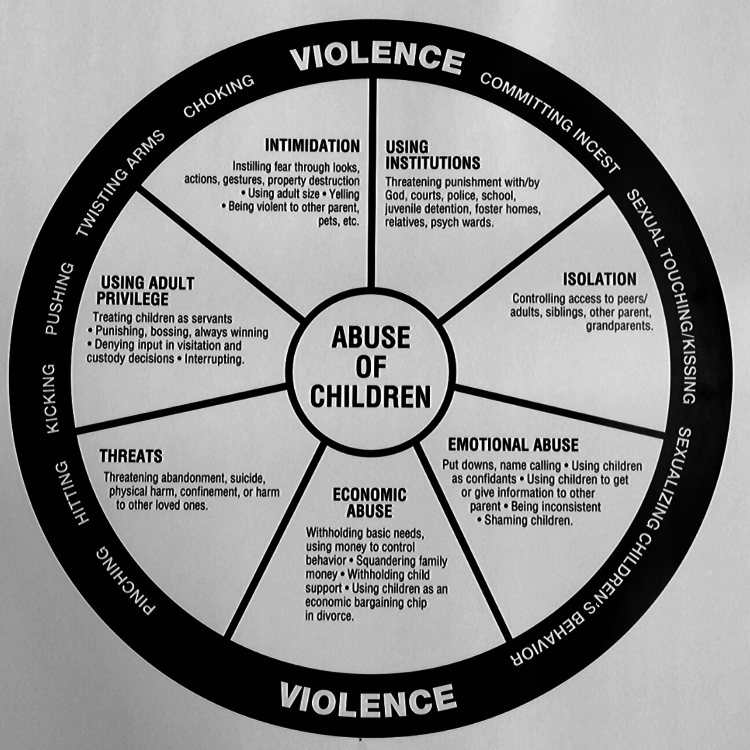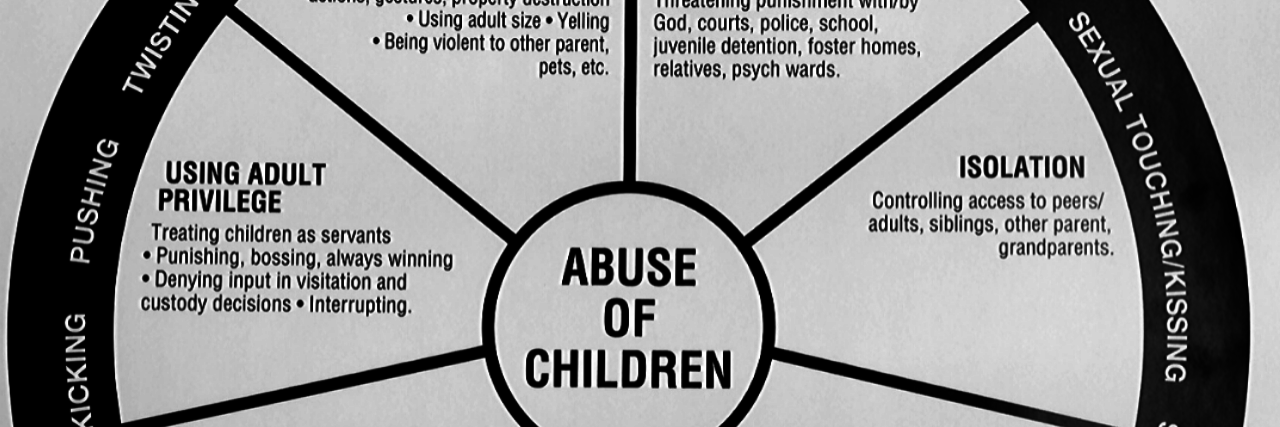The Chart You Might Need If You Are a Childhood Trauma Survivor
Editor’s note: If you have experienced childhood emotional or sexual abuse, the following post could be potentially triggering. You can contact the Crisis Text Line by texting “START” to 741741.
According to ChildHelp, the largest organization dedicated to helping victims of child abuse and neglect, the definition of child abuse is when a parent or caregiver causes (or threatens) injury, death or emotional harm to a child.
Though this definition is accurate, it’s also a bit vague. Like most things, “harm” exists on a spectrum, so it may feel tricky deciding what is “poor parenting” and what constitutes actual abuse. Because the distinction isn’t always clear cut, we wanted to share a tool with you that might help you understand the dynamics of parent/caregiver abuse with more clarity. If you are a survivor of childhood trauma, this chart might aid your healing process.
The Power and Control Wheel for abuse of children, created by Domestic Abuse Intervention Programs (DAIP), is a simple chart that outlines behaviors that constitute abuse. The outer ring of the chart lists acts of physical violence (left side) and acts of sexual violence (right side). Examples of physical violence include: choking, twisting arms, pushing, kicking, hitting, pinching, and the examples of sexual violence include committing incest, sexual touching/kissing and sexualizing children’s behavior.
You can see the chart below, or download your own copy in your preferred language here.

The inner circle of the chart is divided up into seven parts, and encompasses classic behaviors that constitute psychological violence abusive caregivers can inflict on children. All seven of these power and control tactics can fly under the radar, leaving children feeling confused and powerless to prevent the abuse they experience. We’ve broken down each behavior below.
1. Using Institutions
The first section of the chart talks about the use of institutions to maintain power over a child. This could look like threatening punishment by an outside entity (example: “God will punish you for the sin of disobeying your parent”) or threatening punishment with an institution (example: “If you don’t behave, I will send you to live with your mean Aunt Hilda”). Other examples of institutions an abusive parent might use to control a child include threatening punishment by/with:
- Police
- Courts
- School
- Juvenile detention
- Foster homes
- Relatives
2. Isolation
According to the nonprofit Prevent Child Abuse America, adults who use isolation to control their children cut them off from normal social experiences, prevent them from forming friendships and encourage the child to believe they are alone in the world. This may also include controlling access to the child’s other parent, siblings, grandparents or other adults.
3. Emotional Abuse
Unlike physical and sexual abuse, which are two fairly easy-to-categorize types of abuse, emotional abuse can be a little trickier to define. Essentially, emotional abuse refers to a pattern of behavior that causes psychological harm to another person, usually involving verbal degradation and the exploitation of an unequal power dynamic. Some common examples of emotionally abusive behaviors caregivers may engage in include:
- Put downs and name-calling
- Using children as confidants
- Using children to get or give information to the other parent
- Being emotionally inconsistent
- Shaming children
4. Economic Abuse
Economic abuse refers to a caregiver maintaining power and control by exploiting a child’s financial dependence on them. Some behaviors that would fall under the economic abuse category can include:
- Withholding basic needs from a child like food, clothing, shelter or medication
- Using money to control behavior
- Squandering family money
- Withholding child support
- Using children as an economic bargaining chip in divorce
5. Threats
Parental abuse isn’t always literal harm, sometimes it looks like the parent creating a climate of fear by threatening to harm the child, others, their pets or even themselves. Some common examples of threats caregivers use to assert power and control over their children include:
- Threatening to abandon the child
- Threatening to die by suicide
- Threatening physical harm, confinement or harm to other loved ones
6. Using Adult Privilege
In all types of abuse, there is an actual or perceived imbalance of power. In the case of parent-child abuse, a parent or caregiver will use their status as an autonomous adult to inappropriately control a child. When questioned by the child, an abusive parent who uses their adult privilege might say something along the lines of, “Because I’m the parent, and you’re the child,” or “Because I said so.” Examples of misuse of adult privilege include:
- Treating children as servants
- Punishing a child inappropriately or more often than necessary
- Bossing around a child
- Always “winning” arguments
- Denying a child’s input on visitation and custody decisions
- Constantly interrupting a child
7. Intimidation
Intimidation is the use of fear to assert power or control over another person. In cases of parental abuse, this might look like:
- Instilling fear through looks, actions and gestures
- Destroying a child’s property
- Using adult size to intimidate (for example, standing over a child)
- Yelling
- Being violent to the other parent, pets, etc.
If you are a survivor of childhood trauma and recognize any of the behaviors mentioned above, you’re not alone. The trauma you experienced was not your fault, and you deserved better treatment growing up. The good news is it’s never too late to heal from trauma. With the help of a trauma-informed therapist (check out this helpful tool to find one), you can heal from past childhood wounds.
To connect with other survivors who understand, we encourage you to post on The Mighty with the hashtag #TraumaSurvivors. Whatever you’re facing today, you don’t have to go through it alone.
For more on trauma recovery, check out the following stories from our community:
Header image via theduluthmodel.org

